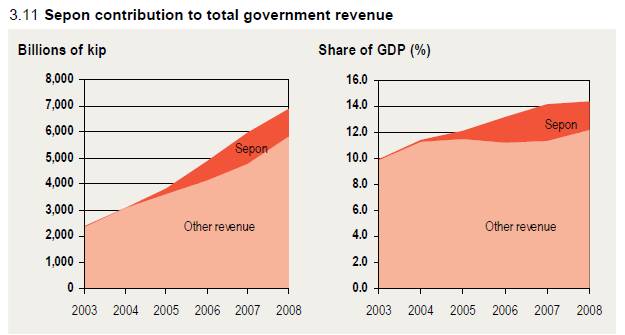The Centre for International Economics, based in Sydney and Canberra, recently published this report on The Economic Impact of the Sepon Mine. Of course, companies like Lan Xang Minerals, which owns the mine, have reasons of self-interest for commissioning such reports. Moreover, critics of the mine would challenge not the scale of economic impact but its distribution, as well as the mine’s environmental impact.
This said, the economic impact of the mine is nothing if not striking. According to the report, it has contributed over 5 per cent of Lao GDP since the start of production in 2003. This translates to an increase of almost one percent a year of GDP growth (over estimated growth without the mine). In addition, the “mine employs up to 40 per cent of the local workforce and up to 70 per cent of local cash income”.
Here is the summary of the report (p. 5):
- The Sepon copper and gold mine, located in central Laos, is a major economic operation, with significant impacts on the Lao economy.
- Since the start of production (gold in 2003 and copper in 2005), the mine has contributed to Lao national income through direct contributions to government revenue, the purchase of a range of Lao goods and services, and employment of Lao nationals.
- Directly, the mine has contributed up to 5.67 per cent of Lao GDP. Indirectly, it has contributed up to an additional 2.56 per cent, bringing its total impact to up to 8.23 per cent.
- This converts to an important contribution to growth in GDP (total value of Lao production) or GNI (income accruing to Laos) per person. Estimates with a simulation model of the Lao economy suggest that without the mine, GDP per person would have grown at 4.8 per cent a year between 2003 and 2009. With the mine, it grew at 5.7 per cent per year.
- Similarly, GNI per person would have grown at 8.2 per cent a year between 2003 and 2009, but with the mine it grew at 8.9 per cent a year.
- The mine operators have gone to some trouble (consistent with their agreement with the Lao Government) to provide local employment and business opportunities. This has resulted in considerable mine based employment in the local area, as well as the development of business enterprises.
- The mine employs up to 40 per cent of the local workforce and up to 70 per cent of local cash income. It has lead to substantive increases in local income per capita, well beyond what would have happened in the absence of the project.
- The establishment of a trust fund has allowed considerable funding for local infrastructure, health and educational facilities.
- At the local level, the mine operates as much like a successful development project as a commercial enterprise. It is, therefore, an excellent example of how the use of natural resources can, in fact, contribute to human development.
- Operations and outcomes from the Sepon project indicate that fears of a ‘resource curse’ affecting Laos can be effectively dealt with through appropriate approaches to the mining task.
 Facebook
Facebook  Twitter
Twitter  Soundcloud
Soundcloud  Youtube
Youtube  Rss
Rss 